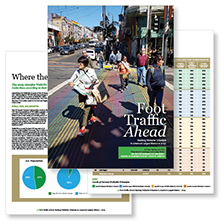Foot Traffic Ahead 2019 Report: The Rise of Walkable Urbanism
 Market share of walkable urban places—also referred to as WalkUPs—in office, retail and multifamily product types is growing nationwide in all 30 of the largest U.S. metro areas, at the expense of drivable suburban. Real estate indicators such as rent premiums, absorption and untapped potential of suburban urbanization positively trend toward the continuation of walkable urban development.
Market share of walkable urban places—also referred to as WalkUPs—in office, retail and multifamily product types is growing nationwide in all 30 of the largest U.S. metro areas, at the expense of drivable suburban. Real estate indicators such as rent premiums, absorption and untapped potential of suburban urbanization positively trend toward the continuation of walkable urban development.
The 2019 Foot Traffic Ahead report released by the George Washington University Center for Real Estate and Urban Analysis, in partnership with Cushman & Wakefield, provides key data and insights into this structural shift toward walkable urbanism and its future growth momentum.
Key takeaways include:
Office, retail and rental multifamily real estate in WalkUPs produces substantial rent premiums.
The disconnect between supply and demand of housing within city center WalkUPs has contributed to affordability and availability challenges.
Higher levels of walkable urbanism are positively correlated with increased educational attainment and economic vitality.
Both the private and public sectors should take note of the proven resilience of walkable urban product and plan accordingly.

